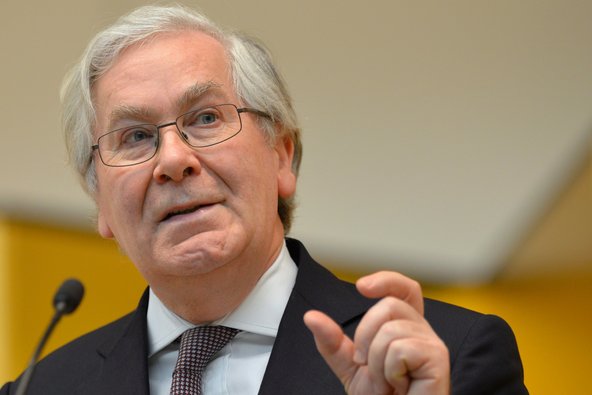 Franck Robichon/European Pressphoto AgencyMervyn King, the departing governor of the Bank of England.
Franck Robichon/European Pressphoto AgencyMervyn King, the departing governor of the Bank of England.
LONDON — British banks must raise a combined £25 billion, or $38 billion, in new capital by the end of the year to protect against future financial shocks, according to a report on Wednesday from the country’s authorities.
The Bank of England, which takes over the direct supervision of British firms like HSBC and Barclays next week, said the new reserves were needed to protect against losses connected to risky loan portfolios, future regulatory fines and the readjustment of banks’ bloated balance sheets.
Mervyn A. King, the departing governor of the Bank of England, said on Wednesday that the need to raise new capital “is not an immediate threat to the banking system and the problem is perfectly manageable.”
Related Links
The report follows a five-month inquiry by British officials into the financial strength of the country’s banking industry. With the world’s largest financial institutions facing new stringent capital requirements, the Bank of England had been concerned that British banks did not have capital reserves large enough to offset instability in the world’s financial industry.
Earlier this month, the Federal Reserve also released the results of so-called stress tests of America’s largest banks, which indicated that most big banks had sufficient capital to survive a severe recession and major downturn in financial markets. Citigroup and Bank of America, after a disappointing performance the previous year, now appeared to be among the strongest.
British banks were not so lucky.
The reported released on Wednesday said that local banks had overstated their capital reserves by a combined £50 billion, which authorities said would now be adjusted on the firm’s balance sheets. Many of the country’s banks already have enough money to handle the accounting adjustment, the report said on Wednesday.
The country’s regulators also said that British banks must raise a total of £25 billion in new capital by the end of the year, but authorities say they believe roughly half of that amount has already been allocated under the banks’ capital-raising plans for 2013. The Bank of England did not name which firms needed to meet the shortfall.
Analysts said on Wednesday that many of the affected firms had enough time to raise new capital by the end of the year, despite the market volatility caused by the banking crisis in Cyprus.
Local regulators have set a deadline for the end of 2013 for banks to increase their reserves to a core Tier 1 capital ratio, a measure of a bank’s ability to weather financial crises, of at least 7 percent under the accounting rules known as Basel III.
Regulators urged banks on Wednesday to increase their reserves by raising new equity, selling noncore assets or reorganizing their balance sheets. British policy makers are concerned that firms will cut lending to the country’s economy as part of their efforts to increase their capital.
“We need safer banks,” said Andrew Tyrie, a British politician who heads a Parliamentary committee on banking standards. “We also need banks that return to normal lending.”
As part of increased oversight of British banks, the Prudential Regulatory Authority, a newly created division of the Bank of England that will have daily regulatory control of the country’s largest firms, will have a direct say in how banks raise the new capital.
The authority’s board is expected to meet over the next couple of weeks to decide which banks will be forced to raise new money. British firms must receive regulatory approval for their capital-raising plans.
Attention is likely to focus on both the Royal Bank of Scotland and the Lloyds Banking Group, which both received multibillion-dollar bailouts during the financial crisis. The banks, which are part nationalized, have recently announced the sale of some of their divisions, including the Royal Bank of Scotland’s American subsidiary, the Citizens Financial Group, in a bid to raise new money.
“We see R.B.S. as most exposed,” Citigroup analysts said in a research note to investors on Wednesday.
Despite the capital increases being in line with many analysts’ expectations, most British banking stocks fell in early afternoon trading on Wednesday, with Royal Bank of Scotland’s share price tumbling the most, at 3.1 percent.
In a statement, the Royal Bank of Scotland said it had announced plans last month to strengthen its capital position. The Lloyds Banking Group declined to comment.
Others firms are taking a different route. After raising $3 billion in November of so-called contingent capital, or CoCo bonds, which converts to equity if a bank’s capital falls below a certain threshold, Barclays is looking to tap investors again through a similar product.
The push to increase cash reserves for Britain’s largest banks is part of an effort to prevent future financial crises. Starting in 2014, the Bank of England plans to conduct regular stress tests of the country’s financial institutions to check that they have sufficient capital reserves.
Article source: http://dealbook.nytimes.com/2013/03/27/regulators-find-british-banks-must-raise-38-billion/?partner=rss&emc=rss